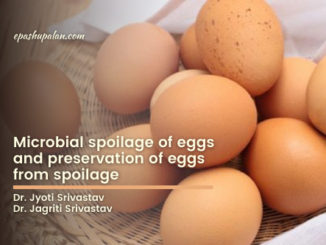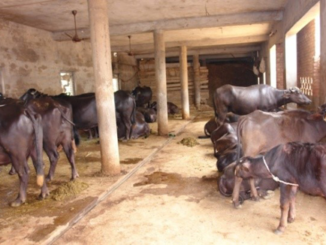The objective of current biotechnology research in agriculture is to increase efficiency of production and to reduce unit cost of world’s food supply. The key of biotechnology is the productivity means efficiency of production. For suitable production in agriculture, the role of biotechnology is enormous. One of these areas for applying biotechnology concept and achieving more efficient production of meat and egg is in the field of poultry nutrition. Since, feed being the major expenditure in commercial production constitutes about 60 to 70% of the total cost of production. Use of biotechnology to improve the utilisation of feed not only reduce the cost of production but also will help poultry industry to get out of the trap of increasing feed cost. On the other hand use of lot of antibiotics as well as in drinking water may cause residual effect in the egg and meat, the consumption of which is detrimental to the health of human beings. In this situation biotechnological approach i.e., acidification of feed, enzyme supplementation, use of bacteria and to enrich feed for better yeast utilization will be better alternative to improve productivity in broilers and layers. Tremendous advances have been made in the use of products such as culture, digestive enzymes, acidification and microencapsulated yeast probiotics. These products coupled with control of the environment by way of reduction in ammonia will enable the feed industry to cope up with the spiralling cost of feed.

Acidification
A complex relationship exists between the efficient between the efficient nutrient utilization and the pH within the digestive system of chicks. This relationship exists between pH and non-pathogenic bacteria such as lactobacillus favouring a low pH range 4-5 and pathogenic bacteria such as E coli with optimum activity at a higher pH range 5-6. The new born chick has nearly a sterile GI tract with a high pH 5-6. This pH is ideal for proliferation of harmful bacteria.
Further, the chicks lack the capacity to produce sufficient acid to maintain the optimal acid pH and thereby the need is created to artificially acidify the GI tract. By lowering the pH which is achieved by conversion of pepsinogen to pepsin retards growth of toxin producing E.coli and enhances growth of benevolent bacteria such as lactobacillus and streptococcus. Further lower pH helps in chelation of minerals and their efficient absorption in the hind gut. Acidification concept is based on efficient utilization of of nutrients. All biochemical and digestive processes are pH and temperature sensitive. Digestive enzymes are mostly active at more acidic pH range. Starch breakdown by amylase is optimal at pH 6.5 where as dextrin breakdown by glucoamylase is optimal at pH 4.4. Providing young birds with an organic acidifier (propionic and acetic acid ) plus supplemental enzymes to enhance the low levels produced by the immature gut is part of digestive assistance concept in this technology.
Probiotics
Etymologically the word probiotics means for life or that which favours life and contrasts the more familiar word antibiotic used extensively for controlling pathogenic microorganisms. The term probiotics was coined in the late 1960’s by R. B. Paker, a microbiologist. Probiotic was intended to describe any microbial feed additive containing living lactobacillus acidophilus cultures. The term probiotic is intended to represent a culture of specific living lactobacillus microorganisms that implant (inoculate) into the intestinal tract of the host to which it is fed. Most commonly used probiotic organisms are listed in Table-1. A breakthrough was achieved in the field of poultry nutrition when the scientists succeeded in orally introducing live lactobacillus acidophilus culture leading to a dramatic improvement in the condition of birds suffering from bacterial or protozoan enteritis.
Table 1 Common Probiotic Organisms
Lactic acid bacteria –
Lactobacillus acidophilus
- bulcaricus
- plantarum
Streptococcus faecium
S.lactis
- thermophillus
- diacetilactus
Other probiotic organisms –
Bacilus subtilis
B.toyoi
Aspergillus oryzae
Torulopsis
Bifucus bifidum
Lactobacilli have been used for ages in the commercial preparation of dairy, grain, fish and meat products, pickled vegetables and silage. They are part of the normal flora of plants and animals, particularly in the mouth, intestinal tract and vagina of many warm blooded animals including human beings.
Pathogenecity is rare, making their use safe to the host, environment and handler. It should be stressed that all probiotic are not the same. An effective product must possess several attributes
- Proper viable bacterial components must be presenting proper numbers for an effective symbiotic response.
- The bacteria must be capable of reaching and colonizing the intestinal tract, which implies that they must be resistant to gastric acid and bile.
- Once ingested, the bacteria must be quickly activated, have a high specific growth rate, and produce acid rapidly (which implies they have an anti-E. coli effect).
- Once the bacteria are administered, they must be able to be tracked within their ecological habitat (i.e. plasmid profiling).
Mechanism of action
Several mechanism have been suggested where lactic acid bacteria (LAB) could inhibit colonization of the intestine by coliforms. They include adhesion to the digestive tract wall to prevent colonization of pathogens, neutralization of toxins, bactericidal activity, prevention of amine synthesis and enhanced immune competence.
Competitive attachment
Surface action through attachment to the intestinal wall is necessary for enterotoxin producing strains of E.coli to induce diarrhoea (Jones and Rutter, 1972). Thus the idea that lactobacilli compete with coliforms for sites of attachment is believed to support proliferation and reduce peristaltic removal of organisms. Evidence supporting competitive attachment between lactic acid bacteria and coliforms was reported by Muralidharan et. al (1977) who found that homogenates of washed intestinal tissue collected from piglets fed L.lactis had markedly higher numbers of attached lactobacilli and lower E.coli counts than scouring or normal control pigs. The ability of bacteria to adhere to squamous epithelial cells appears to depend on attraction between an acid mucopolysaccharide forming the outer layer of the bacterial cell wall and a similar coating on epithelial cells (Fuller and Brooker, 1974). Rapid growth of bacteria in digesta may compensate, to some extent for their failure to adhere to epithelial cells. Through the constant infusion of “friendly” organisms in the diet, colonization of the gastrointestinal tract by pathogenic organisms can be altered, improving health and life expectancy. This idea of competitive exclusion led to the practice of microbial inoculation.
Antibiotic Production
Lactobacilli have been reported to produce various types of antibiotic Lactobacillus acidophilus produces acidophilin, lactocidin and acidolin. L.plantarum produces lactolin. Streptococci produces antimetabolities such as nisin and diplococcin. Furthermore, some of the lactobacilli produce sufficient hydrogen peroxide to inhibit various mocroorganisms. Lactobacillus antibiotic metabolites have shown inhibitory activity against Salmonella, Shigella, Staphylococcus Proteus, Klebsiela, Pseudomonas, Bacillus and Vibrio species and enteropathogenic E. coli. Studies in vitro have shown that an acid condition of less than pH 4.5 prevents the growth of many bacteria including coliforms but still allows the growth of some strains of lactobacilli.
Enterotoxin neutralization
Initial dosing with L.acidophilus has been shown to reduce mortality in chicks challenged with E.coli. Also, continued dosing with L.acidophilus lowers the pH of the crop, caecum and rectum in chicks initially given L.acidophilus or E.coli which demonstrates that L.acidophilus can compete with E.coli in the gut of genotobiotic chicks. Chickens fed probiotics have shown 4% improvement in feed efficiency.
Immunostimulation
The most recently advanced and most provocative mode of action attributed to probiotics is immunostimulation. The microbial flora of an animal has a significant impact on the body’s immune system. The numbers of intraepithelial lymphocytes, plasma cells, and payer’s patches are lower in germ free animals than in conventional animals. Several lactic acid bacteria in cultured dairy products given either orally or intraperitoneally posses antitumor activity and immunostimulation against experimental malignant tumors in mice, rats and guinea pigs. Further, the tumor suppressing effect of lactobacilli is not attributable to the direct cytotoxicity of these organisms, but to some host mediated response.
Raised activities of macrophases and lymphocytes in mice following oral inoculation or intraperitoneal injection with lactobacilli imply an immunopotentiating role for lactic acid baceria in the gut (Perdigon et al., 1986). Evidence of immunostimulation by microorganisms was also observed in piglets. Oral inoculation of germ freeanimals with L.acidophilus led to elevated levels of total serum protein, apparently globulin rather than albumin and increased white blood cells count (Pollman et al., 1980). Experiments conducted in swiss mice revealed that L. acidophillus and Streptococcus thermophillus orally and intraperitoneally. Both of these LAB significantly enhanced the enzymatic and phagocytic activity of peritoneal macrophages compared with controls and accelerated the phagocytic function of the reticuloendothelial system as revealed by carbon clearance test. The activated macrophages and lymphocytes produced the same increase in the immune response whether the bacteria were administered orally or intraperitoneally.
The use of probiotics in poultry nutrition has resulted in an increase in feed efficiency, better quality protein in terms of broiler meat and substantial fall in losses due to infectious diseases. The beneficial effects of the use of probiotics have been attributed to the following factors:
- The antibiotics like acidolin, acidophilin and lactalin produced by Lactobacillus acidophillus organisms are highly effective against poultry pathogens such as E.coli, Salomonella, Shigella, Pasteurella and Staphylococcus.
- The production of organic acids such as formic acid, lactic acid and acetic acid decreases the intestinal pH which is not conducive to multiplication of pathogenic bacteria and coccidia.
- Lowering of oxygen tension in the intestines and some metabolites produced by the L.actobacillus organisms render the intestinal tract less conducive for the aerobic pathogenic bacteria.
- The organisms compete with the pathogenic bacteria for utilizing nutrients available in the gastro- intestinal tract and thus deprive the pathogenic bacteria of their nutrients.
Several commercial preparations in the market under are available various trade names like Biomax, Biospur, Farmore, Lactia-a-bac, Feedmate, Probios, Lactocill, Probiogest and Lactosacc etc. To ensure the viability of bacteria during storage, microencapsulation with water soluble B-glucan has been used by some manufacturers.
Enzymes
The major nutritive components of feedstuffs such as carbohydrate, proteins and fats need to be digested and broken down to sugars, aminoacids and fatty acids by digestive secretions and enzymes before they can be finally assimilated and utilized by the bird. The digestive enzymes are produced in different sites of the gastrointestinal tract and act in response to the feed taken by the bird and these are stable and functional only at specific pH. Enzyme application helps in improvement of feed utilization for better output in two ways
- The young bird in early life lacks enzymes needed for maximum utilization of feed nutrients.
- In other occasions the enzyme complement is adequate but due to the nature of the diet itself further enzyme supplementation has shown to be of significant benefit.
Poultry do not produce enzymes like cellulase, hemicellulase and B- glucanase which are required for digestion of cell wall of plant material. Thus dietary addition of enzymes will be of practical importance in improving the feed value of low energy and high fibre feeds for poultry. Enzymatic treatments such as cellulolytic enzymes combined with commercial proteolytic enzymes have been found effective in chemical alteration of high fibre feed stuffs resulting in improvement in protein digestibility and metabolizable energy. Application of feed enzymes helps in efficient nutrient utilization in the following ways.
- Supporting host endogenous enzyme production
- Rendering nutrients more available for digestion
- Increasing the digestibility of fibre components
- Reducing antinutritional factors.
Due to the time frame involved, it is unlikely that significant fibre digestion could be realized with inclusion of celluloytic enzymes involved in breakdown of cell wall derived substances appear highly effective in improving feed value of barley and rye for poultry feeds. These cell wall constituents such as B- glucans and pentosans solubilizes in the gut and interfere with nutrient assimilation (Campbell et al., 1986; Rickes et al., 1962). Considerable research in the past has shown that the addition of B-glucanase to poultry diets containing rye or barley elicits a significant improvement in feed to gain ratios and weight gains (Marquardt and Fengler, 1985; Hasselman and Aman, 1985; White et al., 1981). The beneficial effects of enzyme preparations which contain cellulases, B-glucanases and pentosanases is that they act on soluble B-glucans and pentosans as well as cellulose. Breakdown of these products helps to make more starch material available for digestion by the birds enzymes. In recent studies supplementation of a mixture of enzymes containing amylase, cellulase, pectinase, protease to a high fibre diet incorporated with rice bran, wheat bran and sunflower cake improved body weight gain and feed utilization (Swain et al., 1996). This study also revealed that economics of production was better in chickens fed high fibre diet supplemented with enzyme compared to those fed control diet.
Significant improvement in body weight and feed conversion ratio was recorded in broilers fed on low energy and high fibre diets supplemented with a multienzyme mixture (Devegowda, 1991). Kadam and Rajmane (1991) obtained significant improvement in the performance of broilers when diet containing maize, ground nut cake, soybean meal and rice polish were supplemented with a commercial enzyme preparation having the activities of enzymes viz., protease, amylase, cellulase, lipase and pectinase. Enzyme supplementation was more effective in unpelleted diet than in pelleted diet. It was found in a study conducted by Nasi University, Helisinki, Finland that laying hens diet based on oat and barley supplemented with multienzyme preparation containing B- glucanase, hemicellulase, cellulase and protease significantly improved feed efficiency.
Yeast cultures
Use of high strength yeast culture gives maximum efficiency in meat and egg production by augmenting the digestive processes. Addition of live yeast contributes to optimal feed utilization by increasing the bio- availability of minerals and by increasing the utilization of feed nutrients (protein, fibre, energy components etc) which further enhances the digestive efficiency. Further it stimulates the growth of anaerobic bacteria in particular Lactobacillus. Additionally the live yeast culture will effectively improve the general flock health characteristics. Limited research is available to explain the practical success of yeast culture in addition to modern poultry rations. However, there are significant commercial application reports indicating the benefits of yeast cultures to poultry diets.
Results of some of the research works suggested that the prebiotic “all natural” programme allows more efficient production of meat and eggs by generating economic advantages in several areas. Increased economy of production is based on the principle that individual producers will realize greater income if more birds are placed (less early mortality) and feed efficiency is improved. Some of the expected benefits of the probiotic feedings are detailed below
- Reduce early mortality day 1 through day 7 by 0.5% or greater
- Cut losses which would have incurred due to E.coli threat
- Sale more meat from birds placed
- Reduces treatment cost per bird placed
- Gives up to 8% improvement in feed conversion and rate of gain
- Add bacteria and enzymes needed to establish intestinal microflora and efficiency
- Improve egg shell quality
- Greater egg quality (thicker albumen)
- Reduction in flock health related problems
Further economic savings are possible in reducing or eliminating the use of antibiotics in poultry diet. When probiotic feeding was compared with antibiotić feeding in commercial conditon, it was found that cost per gain and feed conversion significantly favoured the probiotic group. Addition of high strength yeast culture to layer rations showed that probiotic had a significant positive effect on the efficiency of egg production. Yeast culture in layer feeds increased egg production and reduced the feed requirement per dozen eggs produced.
Conclusion
A scanty scientific literature provides evidence that probiotic organisms have the potential to protect young farm animals against enteropathogenic disorders.
It is time for the nutritionist to evaluate the role of probiotics in the event that antibiotics are banned. As data increase to support the efficacy of probiotics during specific phases of production, the best management scheme may be to incorporate both probiotics and antibiotics, depending on the phase of rearing. Probiotics are expected to be recognized as very useful therapeutic and prophylactic agents in feeding animals. A prerequisite for this funtion is a viable, gastric acidity and bile tolerant strains of lactic acid bacteria which propagates in the gut and is administered at a functional level. Probiotics, particularly Lactobacillus sporogenes which possesses all of the above characteristics can play an important role in modern animal production systems. These probiotics by regulating or enhancing the microbial environment allow the establishment of healthy microflora in the gut of birds, reduce digestive upsets, improve feed utilization and increase animal performance. The increasing impact of probiotic products on animal production will be realized in coming years.
Role of multienzyme mixture is well understood. Multienzyme mixture plays a vital role in improving digestion of feed since poultry feed contains mixture of many feed ingredients in different proportions having many chemical compounds resistant to host endogenous enzyme complex. Hence, versatile use of multienzyme mixture in poultry feed for better utilization of feed as well as to cut down the feed cost will be the future endeavour of feed manufacturers/Nutritionists. However, detail mechanism of individual enzyme action should be the future thrust for achieving success in utilization of fibrous component of feed by the poultry.
Works on the front of the use of acidifying agents is in progress to show their beneficial effect in the digestion process by reducing the pH to a desired level thus favouring growth of beneficial bacteria and inhibiting the harmful bacteria like E.coli. Acidification along with enzyme supplementation (which is produced at a lower rate in young chicks) is a part of digestive assistance in young chicks to favour better growth and health. Hence, supplementation of probiotics and yeast cultures, acidification of the gut and enzyme supplementation are the thrust areas for future research to sustain the production and productivity in poultry farming to make it a sustainable enterprise.






Be the first to comment